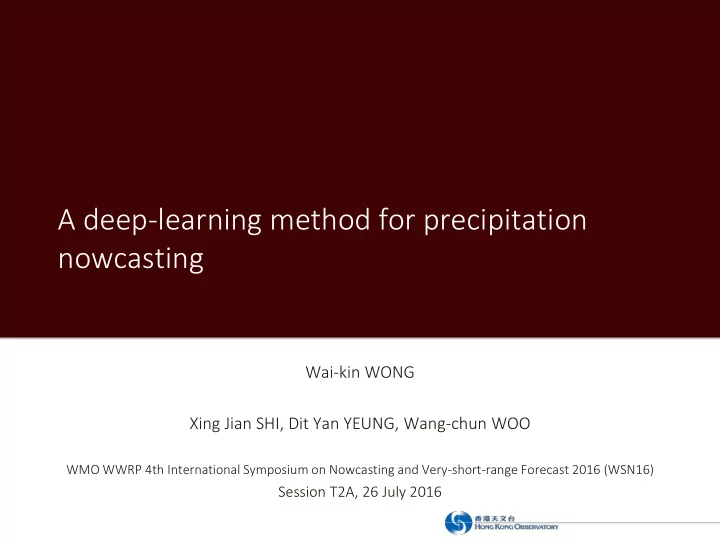

A deep-learning method for precipitation nowcasting Wai-kin WONG Xing Jian SHI, Dit Yan YEUNG, Wang-chun WOO WMO WWRP 4th International Symposium on Nowcasting and Very-short-range Forecast 2016 (WSN16) Session T2A, 26 July 2016
Echo Tr Trackin ing in in SW SWIR IRLS Radar Nowcastin ing Sy Syst stem • Optical Flow • Maximum Correlation (TREC) MOVA – Multi-scale Optical-flow by 0.5, 1, 1.5, 2, … 5 km Variational Analysis CAPPI 64, 128, 256 km range Pixel matrix ROVER – Real-time Optical-flow by TREC EC vecto tor Variational method for Echoes of Radar Searching radius Searching radius Given I(x,y,t) the image brightness at point (x,y) at time t and the brightness T is constant when pattern moves, the T – 6 min pixel matrix with maximum correlation R echo motion components u(x,y) and v(x,y) can be retrieved via minimization where Z 1 and Z 2 are the reflectivity at T+0 and T+6min respectively of the cost function: 1 2 Z k Z k Z k Z k ( ) ( ) - ( ) ( ) 1 2 1 2 I I I N k k k R J u v dxdy 1 / 2 t x y 2 2 2 2 Z ( k ) - N Z Z ( k ) - N Z 1 1 2 2 k k
Predicting evolution of weather radar maps • Input sequence: observed radar maps up to current time step • Output sequence: predicted radar maps for future time steps Maximize posterior pdf of echo sequence across K time levels based on previous J time levels of observations
Sequence-to-sequence learning output sequence y t y t-1 y t+1 s t-1 s t s t+1 x t-1 x t x t+1 input sequence
Encoding-forecasting model Encoding module y t y t+1 copy s t-1 s t s t s t+1 x t-1 x t Forecasting module
Spatiotemporal encoding-forecasting model
ConvLSTM model • Convolutional long short-term memory (ConvLSTM) model X. Shi, Z. Chen, H. Wang, D.Y. Yeung, W.K. Wong, and W.C. Woo. Convolutional LSTM network: A machine learning approach for precipitation nowcasting. NIPS 2015 . • Two key components: – Convolutional layers – Long short-term memory (LSTM) cells in recurrent neural network (RNN) model
Convolution • An operation on two functions • Produces a third function which gives the overlapped area of the two functions as a function of the translation of one of the two functions
Convolution • Continuous domains: • Discrete domains: • Discrete domains with finite support:
2D convolution • 2D convolution (a.k.a. spatial convolution) as linear spatial filtering • Multiple feature maps, one for each convolution operator
Convolutional and pooling layers • Convolution: feature detector • Max-pooling: local translation invariance determines the future state of a certain cell in the grid by the inputs and past states of its local neighbors Size of state-to-state convolutional kernel for capturing of spatiotemporal motion patterns
Convolutional and pooling layers local receptive fields weight sharing pooling input image pooling convolutional layer layer
NN and Fully-connected Recurrent NN Feed-forward NN
From RNN to LSTM
Dependencies between events in RNNs • Short-term dependencies: • Long-term dependencies:
Ordinary hidden units in multilayered networks • Nonlinear function (e.g., sigmoid or hyperbolic tangent) of weighted sum • RNNs, like deep multilayered networks, suffer from the vanishing gradient problem
LSTM units • LSTM units, which are essentially subnets, can help to learn long-term dependencies in RNNs • 3 gates in an LSTM unit: input gate, forget gate, output gate
RNNs with ordinary unit RNNs with LSTM units
Encoding-forecasting ConvLSTM network • Last states and cell outputs of encoding network become initial states and cell outputs of forecasting network • Encoding network compresses the input sequence into a hidden state tensor • Forecasting network unfolds the hidden state tensor to make prediction
Accumulator of ConvLSTM governing equations state information Memory Inputs cell input gate forget gate Cell outputs output gate Hidden states
Training and preprocessing of radar echo dataset • 97 days in 2011-2013 with high radar intensities • Preprocessing of radar maps: – Pixel values normalized – 330 x 330 central region cropped – Disk filter applied – Resized to 100 x 100 – Noisy regions removed
Data splitting • 240 radar maps (a.k.a. frames) per day partitioned into six 40- frame blocks • Random data splitting: – Training: 8148 sequences – Validation: 2037 sequences – Testing: 2037 sequences • 20-frame sequence : – Input sequence: 5 frames – Output sequence: 15 frames (i.e., 6-90 minutes)
Comparison of performance • ConvLSTM network: – 2 ConvLSTM layers, each with 64 units and 3 x 3 kernels • Fully connected LSTM (FC-LSTM) network: – 2 FC-LSTM layers, each with 2000 units • ROVER: – Optical flow estimation – 3 variants (ROVER1, ROVER2, ROVER3) based on different initialization schemes
Comparison of ConvLSTM and FC-LSTM the loss of entropy for ConvLSTM decreases faster than FC-LSTM across all the data cases a better matching with training datasets
Comparison based on 5 performance metrics • Rainfall mean squared error (Rainfall-MSE) • Critical success index (CSI) • False alarm rate (FAR) • Probability of detection (POD) • Correlation Threshold = 0.5 mm/h
Prediction accuracy vs prediction horizon Different parameters are used in ROVER1,2,3 optical flow estimators
Two squall line cases • Radar location (HK) at center (~ 250 km in x- and y- directions) • 5 input frames are used and a total of 15 frames (i.e. T+90 min) in forecasts 30 min Input frames Actual ConvLSTM ROVER2 90 min D t = 18 min
30 min Input frames 90 min Actual ConvLSTM ROVER2
30 min Input frames 90 min Actual ConvLSTM ROVER2
Ongoing Development • Longer training dataset (~ 10 years data) • Adaptive learning to cater for multiple time scale processes • Optimizing performance for higher rainfall intensity based on different convolutional and pooling strategies • Extend learning process to extract stochastic characteristics of radar echo time sequence, features of convective development from mesoscale/fine-scale NWP models
Recommend
More recommend